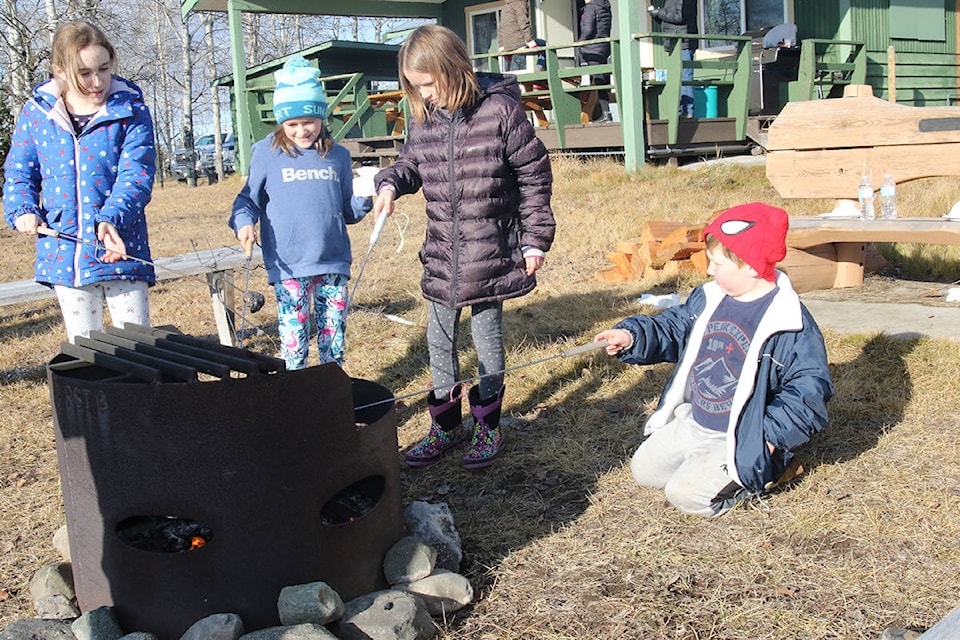The Green Lake Snowmobile Club (GLSC) hosted an open house on Nov. 10, to present the completion of the renovation project to the clubhouse.
More than 50 people attended the two-hour event, says club president John Sullivan.
Four dozen hotdogs were served for lunch, along with chips, coffee, juice and tasty treats. Children and people of all ages enjoyed the marshmallow roast and warm campfire.
“Among our guests was [Thompson-Nicola Regional District Area E Director] Sally Watson who was instrumental with her assistance with the project.”
Sullivan adds the event attracted several new members and gave existing members an opportunity to sign up and pay their annual fees.
A couple from Bridge Lake won the 50/50 draw.
“I want to thank Jeff and Kathy Traynor for organizing the event, as well as the other club members who helped out.”
Fuel mitigation
Following the closure of Norbord in 100 Mile House, the fuel mitigation and second egress route proposal for South Green Lake was up in the air, which was a disappointment for local residents.
However, Rob Martin, who is a land and resource specialist with the Ministry of Forests, Lands, Natural Resource Operations and Rural Development, found other funding to get the projects done.
South Green Lake Volunteer Fire Department (SGLVFD) Chief Peter McKie says Martin called an impromptu meeting because there were some changes. Around 10 residents showed up at the GLSC clubhouse on Nov. 7 where Martin provided new details about pursuing both projects for the community.
The first phase of the fuel-mitigation project goes from Point Road to the Buffalo Ranch.
Maps will be available at the SGLVFD fire hall and the GLSC clubhouse. On the map, there are two areas: orange is for cleanup only, and green is for the fibre that will be taken out for timber sales.
Contractors will be working this winter - likely after Christmas - and it’s expected they will work from 7 a.m. to 4 p.m.
Crews will be pruning, spacing, crowning and burning.
They will be cutting down and stacking the standing dead coniferous trees, and pruning, spacing and crown live ones. They will leave live deciduous trees.
All dead and downed trees will be left on the ground to decompose, but crews will deal with ladder fuel.
Debris piles will be burned in 2020.
There will be piles of wood that area residents can take for firewood.
There will also be marked piles of wood that are for timber sales – residents can’t take wood from these piles.
Crews will be working with the wood from the back of residential property lines to 100 metres out. However, pile burning will not be any closer than 50 metres from the back of private property lines.
On Crown land, however, crews will be working right up to South Green Lake Road, which will help increase the visibility of wildlife attempting to cross the road.
Egress route
Martin also talked about the second egress route off of South Green Lake Road, but that will take time to get underway.
The route will require 800 metres of new road off of South Green Lake Road. However, the access road that will be used has yet to be determined.
The new road will hook up with the haul road that was built when the Nolan Creek cut block was logged. The road will have to be graded.
This will be hooked up to the Jim Lake/Nolan Forest Service Road (FSR), which will have to be cleaned up.
There will be an option to go both ways where the Nolan Trail meets the Pressy Lake FSR. There will be egress signage indicating the route to North Bonaparte Road or to Watch Lake, where one kilometre of new road will have to be built.
Egress drawings and plans are still in the works, and once completed, the road will be a summer-route only, with limited access.
At locations where new roads are required, First Nations assessments must be completed before work can begin.
Fuel management
Recently, there was a successful mixed prescribed burning and a fuel management project in the Nolan Creek site within Green Lake Provincial Park at the end of the Green Lake South Road.
The project was directed by the BC Parks in partnership with the BC Wildfire Service (BCWS) during August and September.
The intent was to mitigate fire risk through prescribed thinning/spacing of trees and removal of excess surface fuels.
The work was conducted by BCWS and the Stormriders Unit Crew out of the 100 Mile House Fire Zone.
During the project, four plots were treated – two on the off-lake side and two on the lake side of the road.
Danger trees were knocked down, standing trees were pruned from two to three metres from the ground. Tree spacing and eliminating ladder fuel were also part of the project.
Accumulated fuel was collected and put in several two-metre-high by three-metre wide piles. Then they were burned if there was adequate venting, so the smoke wouldn’t hang around in the community.
Before leaving the site, crews would extinguish the pile fires every “burn” day with water pumped from Nolan Creek.
Stormriders Unit Crew supervisor Dustin Karolat says any trees that were dead and on the ground had the limbs bucked off so they were completely on the ground where they would decompose faster.
“Then they would then become nurse trees for seedlings.”
Karolat adds the job lasted just over 10 days.
Some of these were half days due to the time they had to spend at base camp, he adds.
“We initially had 20 workers on site. However, even when we had our full complement of crew, we typically split groups up to divide and conquer.
“So most days, we had between five and 15 personnel on site.”
